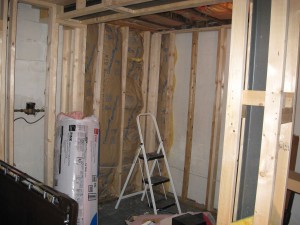 As I’ve previously written, I’ve starting building a small tracking/mixing room for my studio, Getting Better Recording. Even when it’s finished, it will be quite humble by pro studio standards – it’s just a room I’m finishing out in my basement, after all. But I thought it would be fun to share a few things I’ve learned about creating a recording and mixing space from some very smart people.
As I’ve previously written, I’ve starting building a small tracking/mixing room for my studio, Getting Better Recording. Even when it’s finished, it will be quite humble by pro studio standards – it’s just a room I’m finishing out in my basement, after all. But I thought it would be fun to share a few things I’ve learned about creating a recording and mixing space from some very smart people.
I’ll expound on my plan and my choices soon. For now, here are my tips to creating the recording space of your dreams.
1. Know exactly what you want to do there. This is crucial. Will you be recording full rock bands or just one or two acoustic tracks at a time? Will you track live drums? Doing a lot of mixing or mastering?
The answers to these questions will guide much of your plan in terms of space.
2. Know the difference between soundproofing and sound treatment. This also is a hugely important point. Lots of people start out assuming they want to “soundproof” their recording space. But true sound-proofing can be extremely difficult and expensive. Why? Simply put, sound is hard to contain. It takes mass – thick, heavy walls. True sound-proofing also can require decoupling floors and even the ceiling from surrounding structures, a tricky proposition at best.
Now there are a host of products and construction techniques that can help get you there: resilient channel, Green Glue, floating floors, room-within-a-room construction. If you have the time and money, these are all worthy areas of exploration.
Regardless of what you choose in this area, every recording and mixing room needs sound treatment. Which brings us to…..
3. Know the basic principles of treating a room for sound. When it comes to recording or even just listening, walls, floors and ceilings can be your enemy. Why? Because soundwaves tend to bounce off those hard surfaces, creating all kinds of problems for you. In short, the sound bouncing off all those surfaces competes with the sound coming out of your speakers — or your instrument.
So, you need to absorb some of that sound. Now lots of folks swear by the eggshell foam method – just get a bunch of that stuff and attach it to your walls and you’re set.
Wrong.
As has been pointed out in numerous places, thin foam — even that stuff sold by reputable companies like Auralex –– only absorbs high and middle frequencies. It leaves those big bass notes bouncing around, muddying up your sound and wreaking havoc with your recording.
One solution: homemade bass traps and sound absorbers. There are plenty of places to look to see how these things are built; when I build some more I will post the details on how I do it.
4. Set a budget. Then prepare to break it.
Sure, money can’t buy you love. But it takes money to create a good-sounding room. And if your experience is anything like mine, money will be a huge part of the equation. So set reasonable expectations and build a budget around it.
Ok, enough for now. I’ll be back soon with an explanation of some of the choices I’m making.